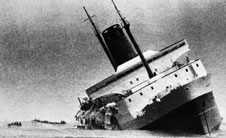 Thursday 2 March 2017 7:45am
Thursday 2 March 2017 7:45am
1968 Wahine - Lifeboat escape
Fewer New Zealanders are now dying in large-scale disaster events but that is not the case across the Tasman, a University of Otago, Wellington study has found.
The study, just published in the Australian and New Zealand Journal of Public Health, was on sudden mass fatality events, with 10 or more deaths, between 1900 and 2015 in New Zealand.
Public health researchers Professor Nick Wilson and Associate Professor George Thomson, who led the work, reported finding 56 such events in this time period.
“We discovered 18 more events than reported previously, partly due to the identification of less well known ship sinkings,” says Professor Wilson.
“There were 1,896 deaths in total from these events, with the Hawke's Bay earthquake of 1931 having the highest death toll (258 deaths). Earthquakes were the most lethal natural event, with three resulting in 460 deaths in total (4.0 deaths per year on average),” Professor Wilson says.
The researchers reported on the possible reasons for this declining trend and looked at ways of improving knowledge about these events.
“The decline in events was largely because of the reduction in transportation-related events – most substantially with ship sinkings, but also for train crashes and aircraft crashes.
“This transportation category reduction probably reflects a large number of factors, such as improvements in: transport vehicle design, marine and aircraft navigation systems, weather forecasting, and safety systems in general.”
But even when excluding the transportation category, they found there was still a statistically significant decline in other types of events as a group.
“This declining trend could be due to such diverse factors as improved industrial safety (though the Pike River Mine explosions in 2010 was an exception to this), improved fire safety in buildings, and in some cases new laws may have helped (for example, after the 1990 Aramoana mass shooting involving semi-automatic weapons, such weapons were made illegal),” says Professor Wilson.
Australia by contrast has recently seen an increase in mass fatality events, due mainly to bushfires and floods.
“If future climate change continues to be rapid, these types of events (along with mass deaths in heatwaves) could become more relevant in New Zealand as well,” the authors say.
However they note that preventive measures can be taken to counter such patterns, as for example deaths from bush fires can be partly prevented by avoiding having housing next to forested areas. Heat wave deaths can also be partly prevented with good building design and other features of urban design such as green space in cities.
The authors also suggest that New Zealand could do more research into this topic area, for example, we don't know much about the non-fatal injuries from all these events.
“A better understanding of the cost-effectiveness of preventive measures is also needed. That is, how worthwhile is upgrading buildings to prevent earthquake-related injuries, versus more spending on preventing cancer or preventing heart disease?
“For example, ending the tobacco epidemic by achieving the Smokefree 2025 goal might save far more lives than improved building strengthening to prevent earthquake related deaths – but we need more detailed analyses to know this for sure,” says Professor Wilson.
A full list of the identified mass fatality events is in the Appendix to the authors' blog about the issue at the Public Health Expert blog site. The blog also has a graph of the time trend in these events and a link to the journal article.
For further information, contact:
Professor Nick Wilson
Department of Public Health
University of Otago, Wellington
Email: nick.wilson@otago.ac.nz
A list of Otago experts available for media comment is available elsewhere on this website.
Electronic addresses (including email accounts, instant messaging services, or telephone accounts) published on this page are for the sole purpose of contact with the individuals concerned, in their capacity as officers, employees or students of the University of Otago, or their respective organisation. Publication of any such electronic address is not to be taken as consent to receive unsolicited commercial electronic messages by the address holder.
